Ravenshaw trying to become a complete university; plans in motion to open a music and fine arts center
Following is from Dharitri.
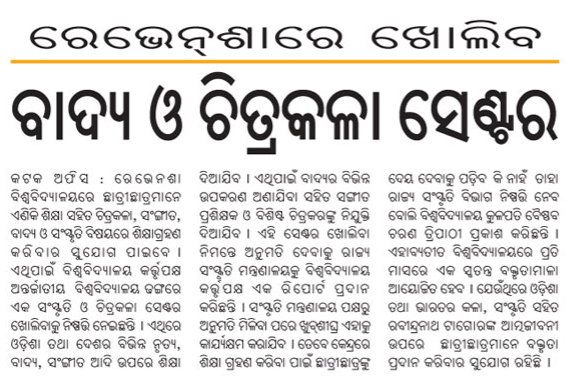
1 comment February 28th, 2012
Following is from Dharitri.

1 comment February 28th, 2012
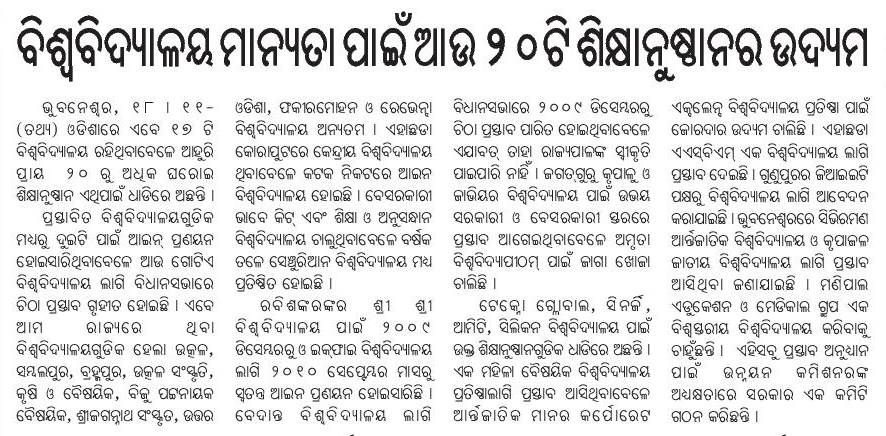
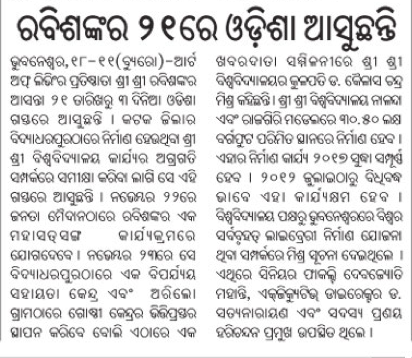
The 30.5 lakh sq feet is equivalent to 2,83,355.4066 sq meters and is equivalent to 70.0158 acres. As a comparison:
November 20th, 2011
Following is an excerpt from Shilpi Sampad’s report in Telegraph.
The prestigious Cuttack university has come up with a novel concept where postgraduate toppers are being given an opportunity to take classes at the undergraduate level in their respective fields for one year. Fourteen toppers have been appointed as “vice-chancellor’s scholars” to be part of their respective departments not only to teach but also to assist in research work, maintain archives and other work. They would be paid a consolidated monthly remuneration of Rs 8,000 from the university funds, said varsity officials.
“The toppers will be involved in departmental functioning and attached to the V-C’s office for executive assistance,” said Chandi Prasad Nanda, head of the history department at Ravenshaw University.
Stating that the programme was the brainchild of vice-chancellor Devdas Chhotray, Nanda said the objective was to guide meritorious students and encourage them to take up teaching as a profession.
“The idea behind this novel initiative is to motivate young scholars to engage themselves in teaching and research work. Here, they would work as interns and can, simultaneously, pursue M.Phil programmes. Through this exposure, they can be sensitised to research trends and pick up teaching skills. It would also prepare them for competitive exams,” said Dipti Ranjan Sahu, head of the sociology department.
The toppers, who have been taking classes since the beginning of this month, seemed happy and excited about being given this opportunity.
“This is an opportunity of a lifetime. I can now understand how difficult a teacher’s job is. We take one to two classes a day and look after other activities of the department. Although it is slightly hectic, I am enjoying every bit of being a teacher,” said Kaikashna Begum, a V-C scholar and gold medallist of the political science department.
This is a wonderful scheme and would encourage many of the toppers to pursue academics, which will help help alleviate the faculty shortage in India.
September 14th, 2011
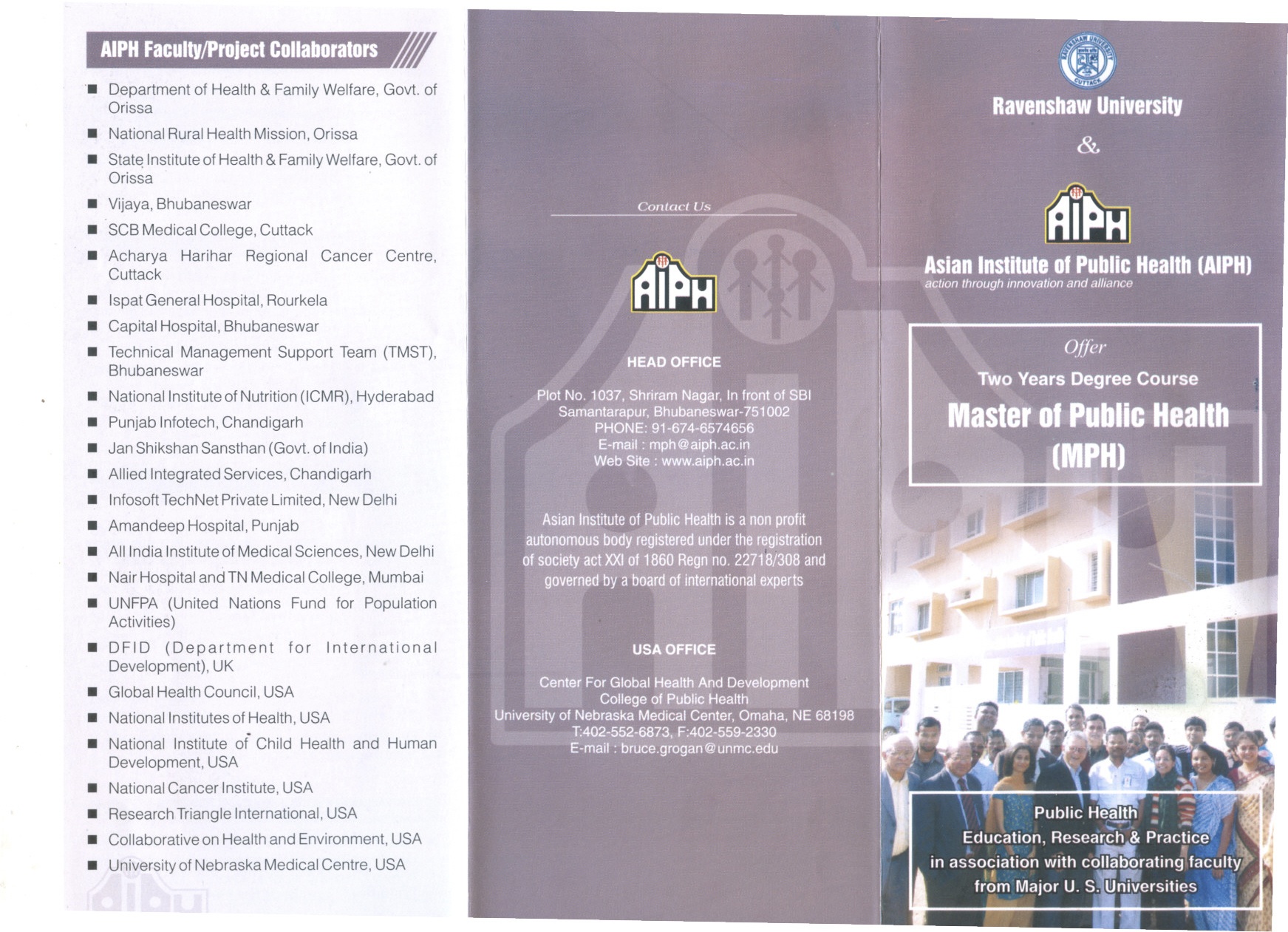
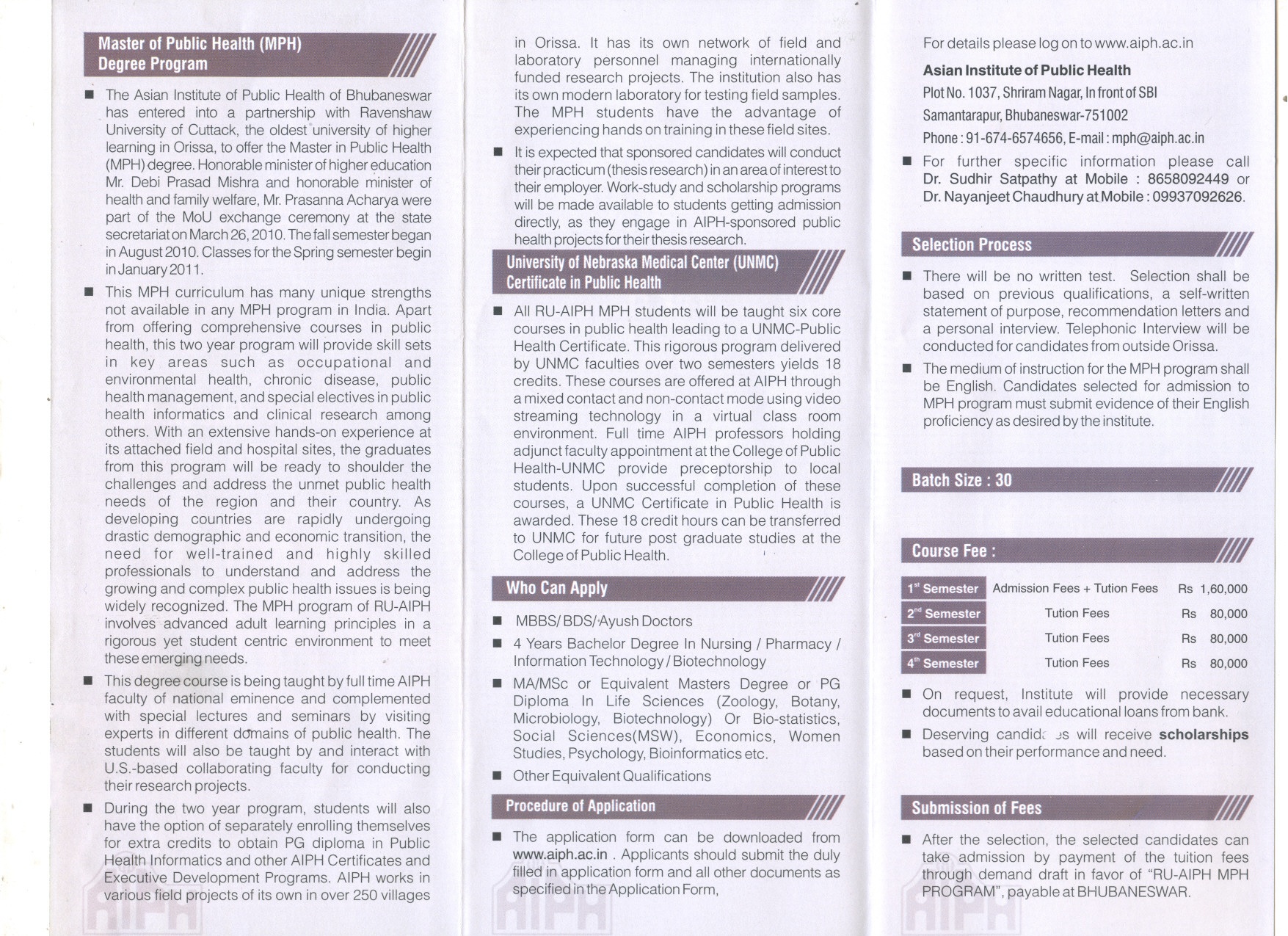
1 comment May 22nd, 2011
Since January 2011 Ravenshaw has started publishing a monthly newsletter. These are available at http://ravenshawuniversity.ac.in/website/ravenshaw-times-(newsletter).htm. Following is an article written by its VC from the first newsletter at http://ravenshawuniversity.ac.in/File/The%20Ravenshaw%20Times%20-%20January%202011.pdf.
Ravenshaw University was set up by the Ravenshaw University Act, 2005. The draft statutes of the University have been pending with the Government for approval. Pending that, the University is referring to the Orissa Universities First Statutes (OUFS), 1990 on the basis of which its own statute has been drafted.
The Ravenshaw University inherited 25 Departments in the disciplines of Science , Commerce and Humanities. In order to upgrade Ravenshaw like the single campus JNU, the University created 11 Schools out of the existing Departments. The Schools are headed by Deans. It takes time for a new structure to be grounded. Therefore academic reforms envisaged are vitally dependent on the faculty. The situation in Ravenshaw was queer. The Government created posts for new faculty only in August 2008, although the University was set up in 2006. For administrative reasons, the Government could not withdraw the old faculty till September 2010. Despite this mismatch, the syllabi in almost all Departments have been revised to cope with contemporary demands. While setting up the University, the Government had not provided adequate faculty to meet the UGC teacher-student ratio of 1:15. The current teacher – student ratio is about 1:50. In order to make it 1:30, which are twice the UGC/ AICTE norms, the University will require 106 new faculty positions. The demand of the University is pending with Government. Ravenshaw has envisioned incorporating all subjects from microbiology to geophysics in its growth. The University has accomplished only a few. The new faculty is still half formed. Many positions for recruitment have been hit by court cases and reservations. It is easy to set up a greenfield institution. It is difficult to deal with old baggage in an institution like Ravenshaw, where the expectations are high and resources low.
Ravenshaw had an identity like none other. In last 50 years it has become fairly pedestrian. When it became a University, it was caught like any other educational institution in the strangle hold of a predicament that is now fairly common. Every educational institution now faces the demand to expand by incorporating vocational elements. MBA, before it was hit by the economic meltdown, was regarded as the flagship course. Ravenshaw, therefore, introduced MBA and set up the Ravenshaw Management Centre, to mark its transition to a University. The Government does not give anything more than the salary grant and some money for infrastructure to the new University. The responsibility of earning by introducing new courses is on the University itself . The Government, in fact had advised in a meeting to consider winding up subjects like Philosophy, Hindi etc. and opening of technology and management courses.
Research in Ravenshaw has been almost nonexistent for many decades, for multipl e reasons. It is believed that given the research achievements of the new faculty, on the basis of which most have been recruited, particularly in science , Ravenshaw will reacquire its earlier fame in scientific research. The new faculty is still in the formative stage.
The Kanika Library wa s indeed the saddest place when the University started. The Library claimed that it had nearly two lakh books in its roll and numerous precious journals but they were thoroughly disorganised. By a hand count, it was found that only 1.12 lakh are available on the shelves. Of the entire lot, only 60,000 have been digitally entered. Precious journals were kept in gunny bags and piled up it some corner. ‘The Ravenshavian’ issues of an entire decade , which were almost falling off like debris , have now been scanned and made available in our website. The antique books of invaluable worth were rotting in a mezzanine floor to which there was no easy access. The only transaction with the students was for some textbooks. Due to lack of grant, and more than that, of involved interest, there was no accretion. The University has started renovation of the Kanika Library and the Centenary Library, which houses the textbooks on a massive scale. The renovation comprises conservation of the heritage structure, redesigning of utility areas and digitalisation with e-library. Already some beginning of the e-library has been made by storing about 80,000 PDF books and one lakh music files in the library server. In brief, the old Kanika Library is emerging now a s the new Ravenshaw Knowledge Centre (RKC) with other such auxiliary activities that a knowledge centre entails.
As for hostel accommodation, Ravenshaw has a low satisfaction of 23%. All its dilapidated hostels with leaking roofs, and their infrastructure falling apart have been renovated, if not fully. Only the West and East Hostels have been specially renovated. The University has spent nearly R s 8 crore of its precious money on the repair and renovation of hostels. Besides, a projection has been worked out to raise the level of satisfaction by another 25%, through construction of six new girls’ hostels and three new boys’ hostels at a tentative cost of Rs 27 crore.
There is a difference between beautification and restoration. Beautification is optional but restoration is always expensive, if it is done with quality. A historic institution like Ravenshaw, whose infrastructure has greatly decayed, due to years of negligence, requires extensive restoration. The restoration of Ravenshaw College Hall, which once housed the Odisha State Assembly, was expensive. The restoration of Kanika Library is going to be expensive. Such expenditure is unavoidable if they are restored with quality. Many visitors, including the Chief Minister, who have seen the restoration of the Heritage Hall have admired it.
Desecration of statues had started long before the University was founded. Front area of the college was congested with growth of wild bushes, half masonry walls, dividers, broken tennis courts with potholes, and littered garbage. All the three statues were installed on pedestals in that nearly abandoned front area, with plasters peeling off them, and all discoloured. They were left open to the vagaries of both nature and men. The University decided to renovate the front area with a huge green lawn and wrought iron gates and boundaries, making the view of the majestic college building visible to the road. While clearing all impediments to the view, the statues too were removed. While removing them the University had discussed with their donors, and assured them that they will be reinstalled either in the front porch or in the Kanika Library building after they are renovated. The renovation work is in process.
The backbone of a University is its faculty. The old faculty was highly underexposed. The new faculties, chosen on the basis of an open competition and global advertisement, have brought tidings from other shores. I am sure they would gradually settle down and also incorporate the best practices they have experienced. When I was a student at Ravenshaw four decades before, we had tutorials. There is none now. The high teacher-student ratio makes it impossible for any exclusive supervision. Besides, the culture had so deteriorated tha t even after it be c ame a University, most of its faculty, particularly those who stayed at Bhubaneswar would leave the campus before early afternoon. I hope the new faculty does not fall into the same rot.
Ravenshaw University shall continue to be a blend of the old and new. For over a century it had been the home of classical studies. In its new version, it will now cope not only with new theories but more so with applications. Ours is a knowledge economy. But the creation of economic wealth must not be at the expense of cultural wealth and insight.
The Ravenshaw University has been in existence for some years. It should have incorporated a few best practices of the best universities of the world. I would like to believe that the University is about intellect. The intellect of a University is the sum total of intellect of its faculty and students. I trust the new faculty. I trust the students of Ravenshaw.
In the faculty recruitment front, the newsletter had the following to say:
After receiving Government’s approval for creating 153 faculty positions comprising 17 posts of Professors, 45 posts of Readers and 91 posts of Lecturers, Ravenshaw University took up this mammoth recruitment enterprise by global advertisement for the faculty positions and received more than 7,000 applications.
It lists 75 new faculty that have been hired. With respect to the quality of the new faculty its goes on to say the following:
The university now boasts of faculty members who have joined the university with their successful research and teaching career in universities abroad. As a Humboldt Fellow, Pradipta Mohapatra, a leading botanist of the country with his focus of research on toxicity of insecticides on algae and cyanobacteria has worked in Rostock and Duesseldorf Universities in Germany. Similarly, the two other botanists, S.K. Naik and N.R. Singh have done their postdoctoral research in the Universities of Kentucky, US, and Stellenbosch in South Africa respectively. Rupashree Shyama Roy, a young scientist with research in molecular modeling and computational chemistry has worked in the Universities of Munich and Leipzig, Germany. Another young scientist, Kumar Siddhartha Kesav Varadwaj with his research interest in nanoscience and technology has been associated with Hokkaido university, Japan and Korea Advanced Institute of Science and Technology. Yet another young faculty of chemistry, Sabita Nayak has worked on the design and development of cardiovascular drugs as part of her postdoctoral research in the University of Texas. Apart from teaching and research on contemporary economic issues, the department of economics has started addressing the problems of rural Orissa. Economist Dr. Mamata Swain, with a Ph.D. from London, is the lead in this regard. Nachiketa Das with a dual citizenship status of India and Australia and being a permanent resident of Japan now heads the department of Geology. With a postdoctoral degree from Harvard, he has been associated with universities of Glasgow, Melbourne and Hiroshima in several academic capacities. Dipti Ranjan Patnaik, who has been both a Fulbright Fellow at Ohio State University, Columbia and an Indo-Canadian Fellow, and has recently received the prestigious Erikson Scholar-in-Residence Position, has already spelt out the roadmap for his department of English. The list goes on. The idea here is not to undermine the achievements of individual faculty members of other different departments by citing a few cases at hand. What needs to be stressed here is the clinical precision which has gone into the process of selection of the core faculty of the university. As one traverses through the departments cutting across humanities, social sciences and natural sciences, the possibilities of having an engagement with ‘ignited minds’ who seek to question meta narratives, becomes absolutely inescapable. In fact, this core faculty of the university in many ways than one is going to shape the texture of academic discourse not only for the university but also for the society at large.
The Ravenshaw website at http://ravenshawuniversity.ac.in/common/faculties.htm has the latest list of the faculty with their short biographies and their phone numbers. I also noticed that some of the faculty have foreign post-doctoral experiences, a couple have Ph.D from abroad, some have experience outside Odisha, some with Ph.Ds from IITs, and many with good publication record.
So it seems like a decent start. Having only one Mathematics faculty is worrisome though. If that can be strengthened and more Physics faculty is hired then Ravenshaw could develop good science programs, such as a 5-yr program in collaboration with NISER.
3 comments April 14th, 2011
August 30th, 2010
Earlier we reported on the shortage of Math Ph.D’s in India. Slowly the Bhubaneswar area is emerging as a center for Mathematics starting from mentoring at the high school level (at IMA) to pursuing Ph.D at NISER, IIT, Utkal and Ravenshaw. There is also a good chance that one of the proposed 10 science magnet high schools will be established in this area. (The top Math center in India is Chennai which has IIT Madras, Institute of Mathematical Sciences and Chennai Mathematical Institute.) Below we list Math faculty (mostly with Ph.Ds) in institutes and universities in the Bhubaneswar area.
Related pointers from the past:
August 4th, 2010
The first article is from Samaja and the second is from Dharitri.
It is good that Ravenshaw is introducing many new programs; I wish and hope that it would also strengthen the traditional programs.
April 28th, 2010
April 26th, 2010
April 22nd, 2010
Update2: Excerpts from Expressbuzz.
An MoU was signed between Ravenshaw University Vice- Chancellor Devdas Chotray and AIPH founder secretary Dr Pinaki Panigrahi for the launch of the Masters in Public Health (MPH) programme. Besides imparting comprehensive skills in public health, the course would turn students into experts on occupational and environmental health, public health informatics and clinical and behavioural sciences. With an extensive hands-on experience, they will pass out as professionals ready to shoulder the challenges of the rise of chronic, infectious, occupational and environmental health problems that are vital contributors to high infant and maternal mortality in the State.
The first of its kind programme in Orissa is accreditated by the Council of Education on Public Health (CEPH) under the USA Government. The students would also gain credit points that would facilitate pursuance of higher studies in the US if they so willed.
But, foremost, the programme would churn out the much needed manpower in the State. There are at least 10,000 jobs for public health professionals in the district and block level under the National Rural health Mission. This apart, public health professionals are much sought after by private health sector enterprises, national and international agencies.
Update: Dharitri’s take on this.
The Asian Institute of Public Health in Bhubaneswar has announced a PG Diploma program in Public Health Informatics. This course will start in September 2010. Some details on the course obtained from their page http://www.aiph.ac.in/academics.html is as follows:
Post Graduate Diploma in Public Health Informatics (24 Credits, 12 months course begins 1st September, 2010)
The objective of this course is to help individuals gain knowledge and skills in informatics concepts and applications and advance the use of informatics in risk assessment, disease monitoring and disease surveillance. The course provides an opportunity for the students to understand the information system architecture in public health, privacy, confidentiality and security issues related to health information systems. Graduate students from all disciplines are eligible for this course that will be offered online three times a year. The course consists of the following modules:
· Introduction to Public Health Informatics (IPHI) – Basics of public health informatics, core competencies of public health professionals, and systematic review of public health information systems.
· Foundation of Health Information Systems (FHIS) – This course is designed to help individuals gain knowledge and skills in public health standards, databases, privacy, confidentiality and security issues relevant to public health information systems.
· Applications of Public Health Informatics (APHI) – overview of clinical decision support systems, Geographic Information Systems, public health surveillance systems.
· Computer mediated Health Education and Health Promotion (CMHEHP) – Web based approaches to health education and health promotion, role of health literacy and varied learning needs of public health consumers and different stakeholders.
· A 12 credit informatics research project will be required to get the Post Graduate Diploma in Public Health Informatics.
The institute seems to have a strong faculty. See http://www.aiph.ac.in/Indian.html.
Surendra K. Mishra, MSc, PGDA, DCS
Health systems, behavioural sciences research and communication, reproductive health
Ashish Joshi, MD, MPH
Public health informatics, health outcomes research, design of multi-component interventions
Niharika Khanna, MD, DCH
HPV epidemiology, cervical cancer, cancer vaccinesPrasanna Nair, MD, MPH
Maternal and child health, epidemiology, HIV/AIDS
P N Padmanabhan, PhD, FAAASc
Nutrition, non-invasive methods for monitoring gastrointestinal health, cancer prevention
Seba Mohapatra, MD
Maternal health, health systems
Pinaki Panigrahi, MD, PhD
Epidemiology, field surveillance, human research protection, clinical trialsP. K. Senapati, MD
Health systems, health care delivery and administration
S. Ramanathan, MPhil
Health economics and finance, reproductive health, gender and equity
Preethy Nayar, MBBS, MPhil, PhD
Health services research & administration, program and policy evaluation
Shireen Rajaram, PhD
Social and behavioral sciences, access to health care, health care disparity
Pritish Nanda, PGDHM, MPH
Health communication, hospital management, social mobilization, program managementE. Venkata Rao, MD
Epidemiology, financial management
Patrik Johansson, MD, MPH.
Health communication, community-based participatory research
Ayman El-Mohandes, MD, MPH
International health, program evaluationJ. Glenn Morris Jr, MD, MPH&TM
Infectious diseases, Cholera, emerging and re-emerging diseases
Ira H. Gewolb, MD
Newborn health, biostatisticsJudith A. Johnson, PhD
Infectious diseases, antibiotic resistance, clinical microbiologyMagda G. Peck, ScD
Leadership development and practice, childhood well being evaluation
Chandran Achutan, PhD
Occupational and environmental health
Hala Azzam, PhD, MPH
Workforce development and training, field assessments, HIV/AIDS
Hrishikesh Chakraborty, DrPH
Biostatistics, epidemiology, cluster randomized trials
James Sherry, MD,PhD
Health policy, international healthJaime Gofin, MD, PhD
Program evaluation, community-oriented primary careLi-Wu Chen, MHSA, PhD
Health economics, cost-effectiveness analysis, health care utilization by underserved population
KM Monirul Islam, MBBS, PhD
Epidemiology, international health, development of surveillance system and evaluation
Ge Lin, PhD
GIS and spatial statistics, statistic methods for defining and quantifying their spatial signals
This instiute will add to the public health offerings in India which include various IIPH offerings such as:
The IIPH in Bhubaneswar (different from the AIPH) is also scheduled to start in July 2010. The AIPH and IIPH in Bhubaneswar will make Bhubaneswar a strong public health education destination. I hope both will spread their wings across Odisha so that some of the current public health issues of interior Odisha are adequately addressed. I am told AIPH is already doing that and has research projects involving interior and tribal Odisha.
Pioneer reports today that AIPH has signed an MOU with Ravenshaw University. This is a great partnership and beneficial to both.
5 comments March 27th, 2010
See the news item at http://www.tathya.in/2009/story.asp?sno=2611.
1 comment February 12th, 2009
Following is excerpted from a report in tathya.in.
7 comments November 17th, 2008
| M | T | W | T | F | S | S |
|---|---|---|---|---|---|---|
| 1 | 2 | 3 | 4 | 5 | 6 | |
| 7 | 8 | 9 | 10 | 11 | 12 | 13 |
| 14 | 15 | 16 | 17 | 18 | 19 | 20 |
| 21 | 22 | 23 | 24 | 25 | 26 | 27 |
| 28 | 29 | 30 | ||||